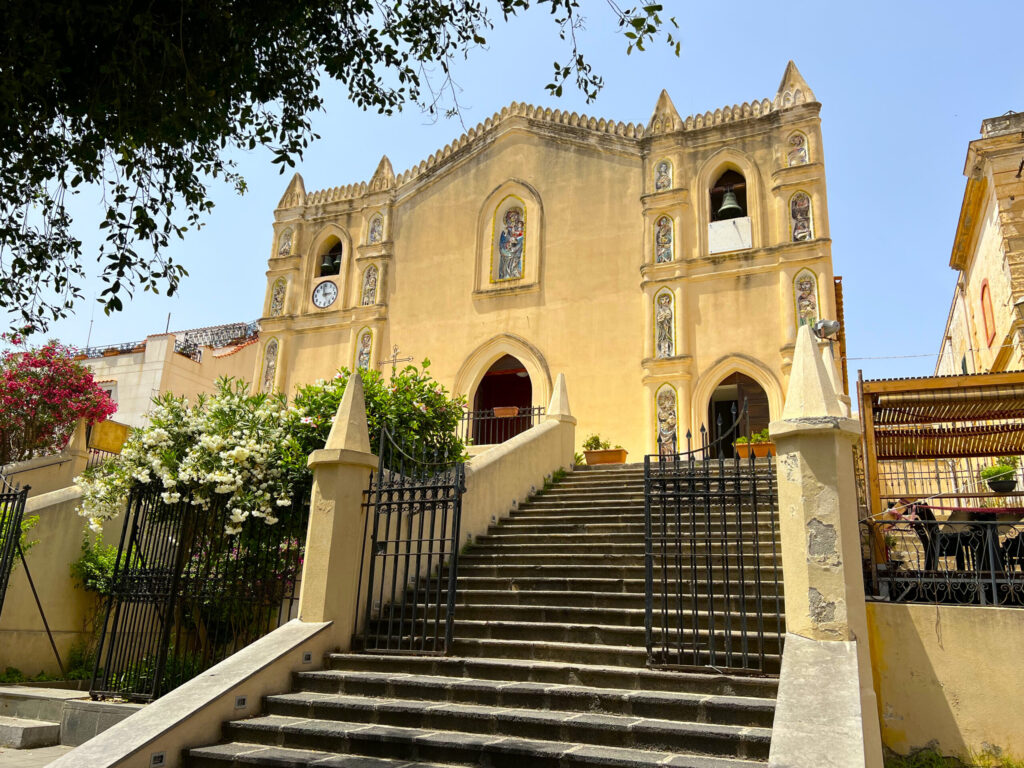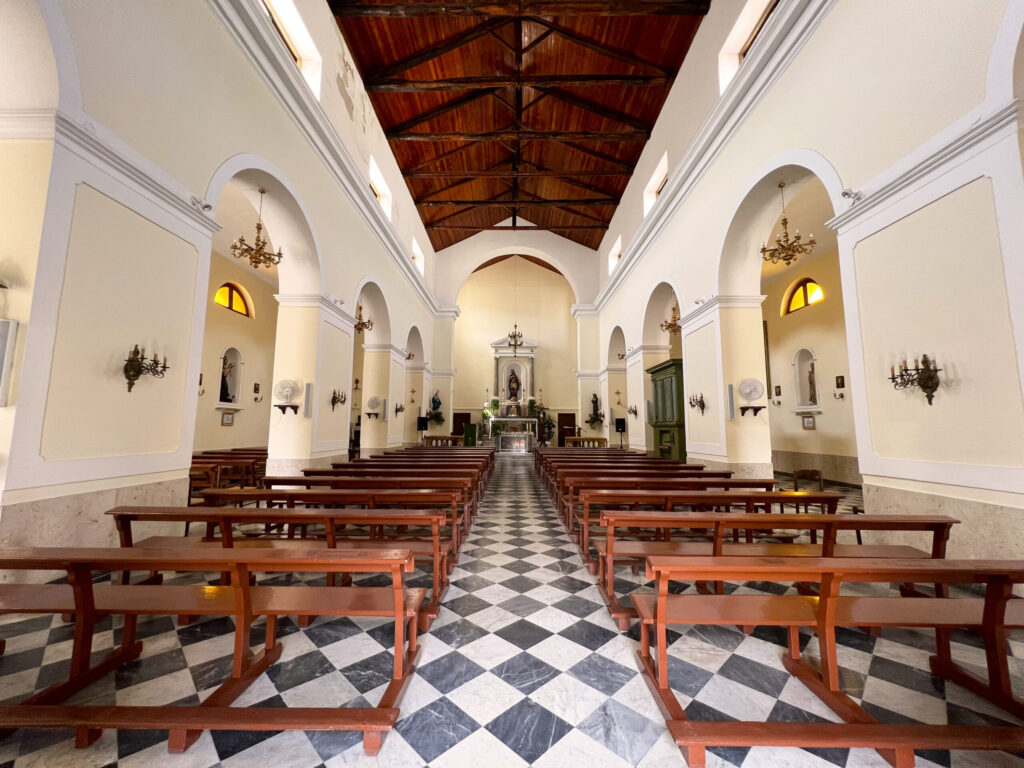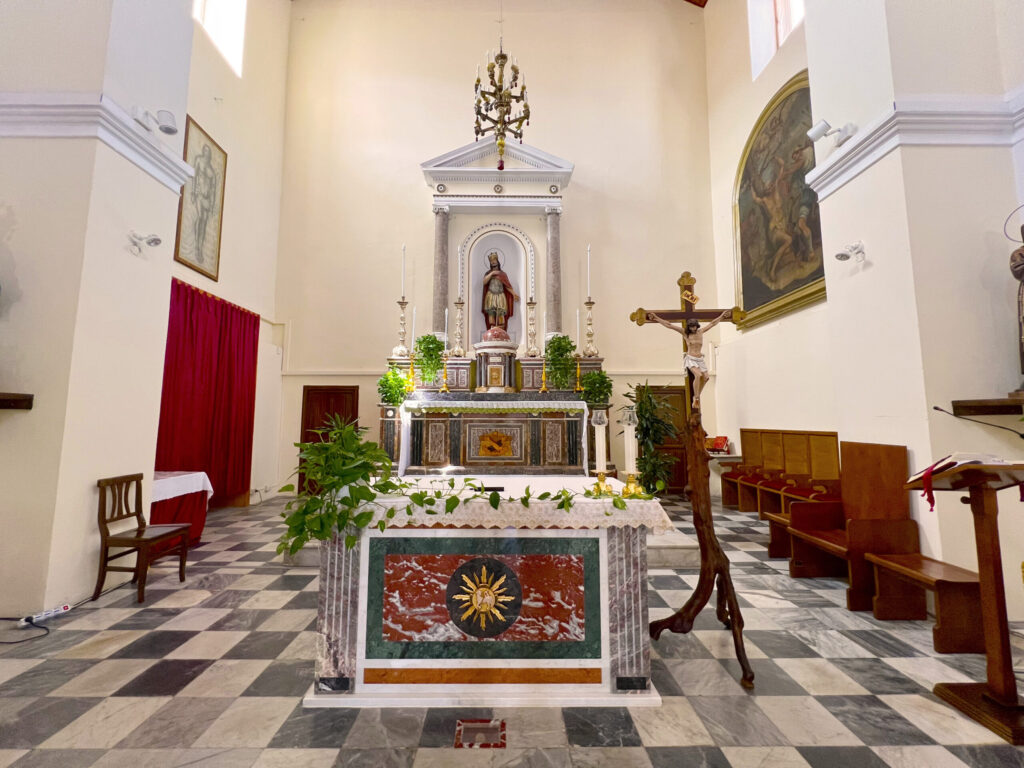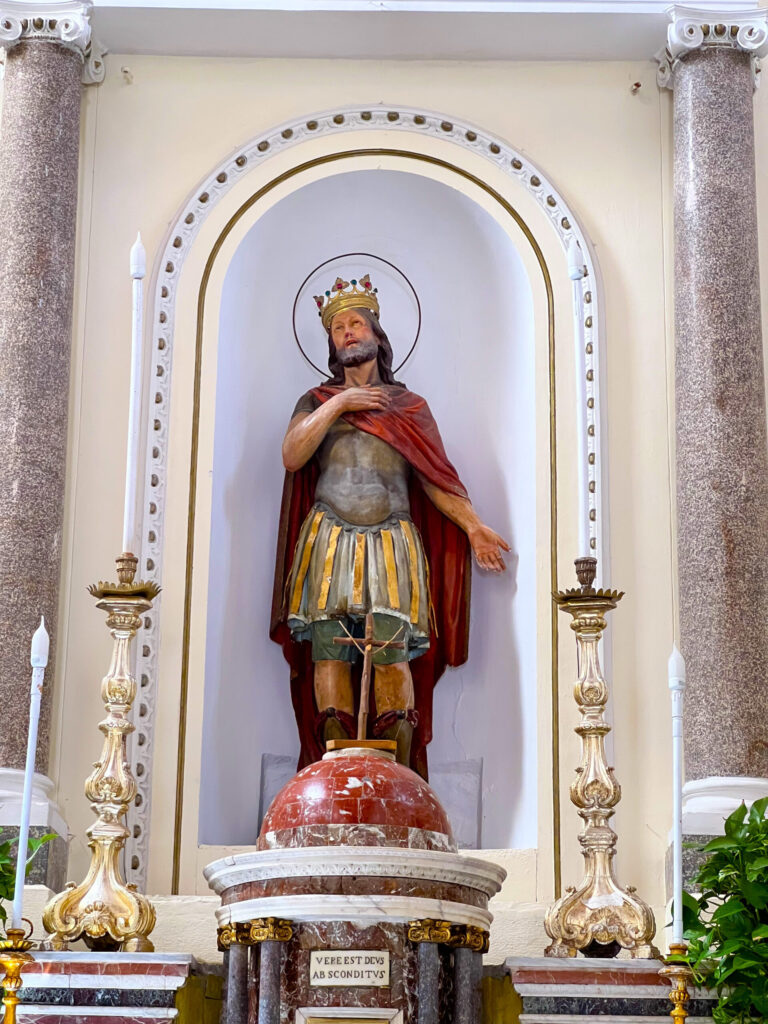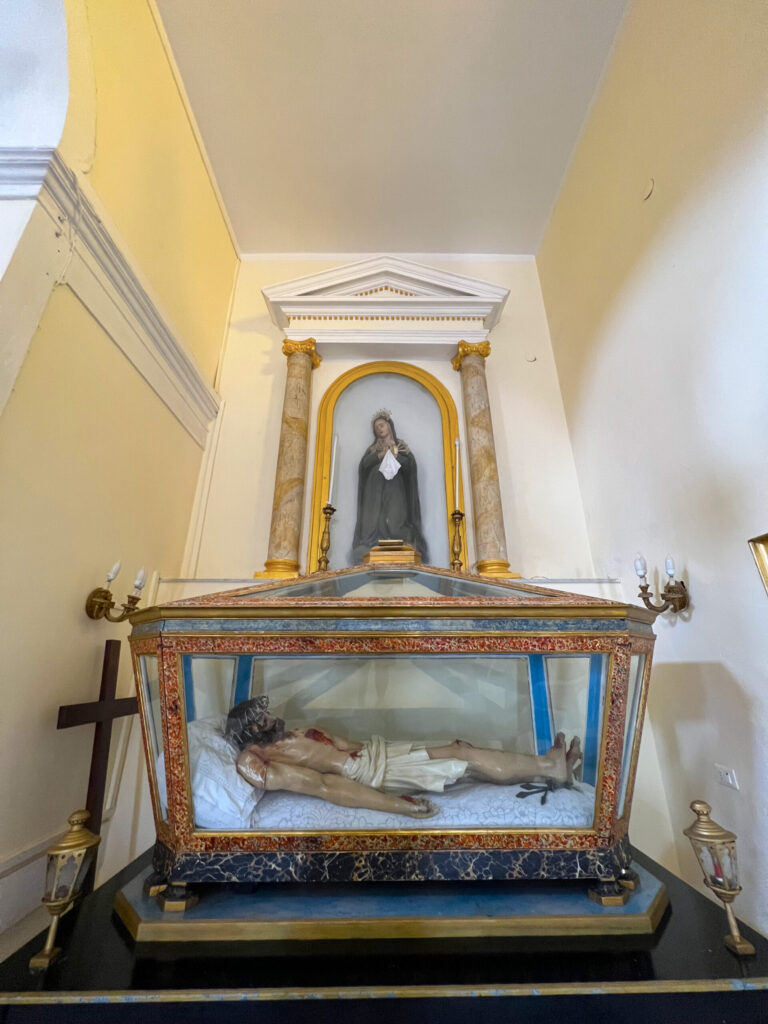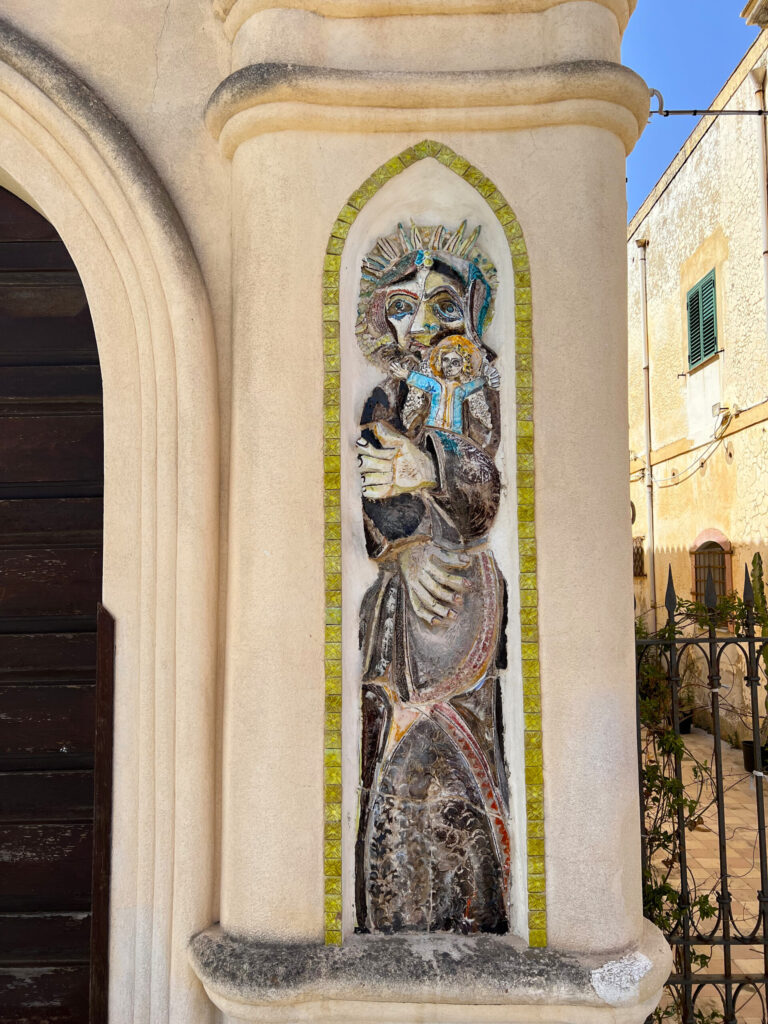St. Ferdinand King Church – Ustica between faith and religion
The immersive experience of Ustica's church and its activities revolve around local religious traditions, where visitors become participants in the islanders' customs and beliefs, immersing themselves in one of the community's most intimate realities.
Symbol
Pink Pin
Distance
In church 500 meters. For processions, they can range from 200 meters to 3 kilometers.
Suitable for
Adults Children and teenagers Families
Description
Cultural-religious experience. The experience focuses on faith, sacred sites, and the history of religious worship on the island.
The Church of St. Ferdinand King is located in the town’s central square and was built in 1768 by the Bourbons. Beneath it lies the crypt, while the adjacent rectory houses the parish library, which contains 15th-century books bound in cowhide, as well as the Museum of Faith. Above all, this place stands as the heart of the island’s religious history, where visitors can immerse themselves in local traditions.
The route length varies depending on where local religious traditions are celebrated. The itinerary is accessible to all.
Holiday Dates:
– St. Joseph – the Sunday closest to March 19
– Easter – during Holy Week
– Madonna of the Fishermen – the last Sunday of May
– St. Bartholomew – August 24
– Madonna of the Flames – first Sunday of September
– St. Bartolicchio – second Sunday of September
– Christmas – December 19 to 26
Highlights
The most imposing building, located behind a small platform with four trees and dominating the town center, is the church, completed by the Bourbons in 1768. The churchyard is very picturesque: it features a double lateral staircase leading to the central structure, whose façade consists of a single large block topped with battlements. The exterior is cream-colored and perfectly symmetrical, with two side towers housing bell chambers, surrounded by votive shrines containing embedded statues and decorations.
Inside, the Church of San Ferdinando Re is simpler and more linear, with very austere walls. The main altar, however, is far more dramatic, with more pronounced and lavish decorative elements. Previously, settlers held religious services in the Old Church, which was adapted from the foundations of the medieval convent dedicated to Santa Maria dei Sette Dolori. The church is dedicated to San Ferdinando Re, the Castilian king Ferdinand III, who lived in the early 14th century and was deeply devoted to the Virgin Mary and Christianity. The construction was promoted by the future king of the Kingdom of the Two Sicilies, Ferdinand I of Bourbon. The building process was far from easy—the church suffered structural collapses twice due to floods, once the year after its construction and again in 1776. Between 1830 and 1835, two side aisles were added to the original structure, decorated with ten niches, nine of which contain statues of saints, while the tenth is covered by a large painting.
In the left aisle, in order, we find statues of: Saint Rosalia, Saint Therese, Saint Joseph, the statue of Saint Bartholomew, and the Sacred Heart with a tabernacle beneath. The right aisle contains: the statue of Saint Anthony, a painting of the Baptism of Jesus, statues of Our Lady of Fatima, Pope John Paul II, and Our Lady of Sorrows. The left aisle is dedicated to Saint Bartholomew, the saint brought from Lipari in 1761 who became the patron saint of Ustica; his statue, placed at the end of the aisle, was sculpted two centuries ago by the Palermo artist Salvatore Bagnasco. The right aisle is dedicated to the veneration of Our Lady of Sorrows—the statue is placed at its end—a centuries-old devotion brought to the island by Benedictine monks.
The central complex around the altar—typical of Bourbon architecture—is dominated by the statue of San Ferdinando Re, placed on the old tabernacle, while the side walls feature two paintings: on the right, The Martyrdom of Saint Bartholomew by Vito d’Anna, a Sicilian painter from the first half of the 18th century, and on the left, a faithful reproduction of the Holy Shroud.
In the center of the third arch of the right aisle stands a precious organ built in 1867, costing 1,402.50 lire at the time. Specifically: “£1,000 were sent to the parish priest by Ustica residents living in New Orleans, £127.50 advanced by the treasury of Saint Bartholomew the Protector, and the remainder was paid by the parish priest himself,” as recorded by priest Giuseppe Tranchina in his book The Island of Ustica from Ancient Times to the Present Day.
In the 1960s, the organ underwent unfortunate modifications that rendered it unusable. Restored in 2011 by the Artigiana Organi workshop in Aci S. Antonio—thanks to public funding and a private donation from the late Ustica native Elena Maria Concetta Maggiore—it is now housed in a wooden case with shutters painted Sicilian green. To the right of the keyboard are the stops for the following registers: Principal, Octave, Flute Piccolo, Flute in VIII, XXVI, XXII, XIX, XV. Though small, the organ is a historical testament to Ustica’s life and Sicilian organ craftsmanship.
Around 1950, the church’s exterior façade was restored and decorated with seventeen niches, later adorned in the 1970s with majolica bas-reliefs depicting various saints, crafted by renowned Sicilian ceramicist Giovanni de Simone. In May 2017, during a restoration promoted by the local parish priest, a catacomb-like structure—long known but sealed in the 1950s—was uncovered in the church crypt.
This underground cemetery features a central chamber with an altar, frescoed vaults, a depiction of a starry sky, and side tunnels with burial niches for bodies awaiting mummification. After the “thanatopraxy” process, the deceased—mostly notable Ustica residents from the late 18th and 19th centuries—were displayed in these niches. The restored sacred space was inaugurated and opened to the public through organized meetings and conferences.
The religious activities most deeply felt by this church and its devotees include: Saint Joseph’s Day, Easter, Our Lady of the Fishermen, Saint Bartholomew, Our Lady of the Flames (*Madonna delle Vamparine*), *San Bartolicchio*, and Christmas. These celebrations are not only expressions of faith but also highly folkloric and well-attended, offering visitors a unique opportunity to experience local spirituality and traditions.
Thus, in this section, you can enjoy two experiences: one related to the festivities and the other to the church building itself.
For the Feast of Saint Joseph, the patron saint of the poor and forsaken, there is a tradition of reenacting the Holy Family’s search for shelter. Days before the celebration, the names of three children chosen to portray the Virgin Mary, Saint Joseph, and the Baby Jesus are drawn in church. On the Sunday closest to March 19th, dressed in elaborate costumes and accompanied by a donkey and a procession of people, they knock on three houses seeking hospitality. At the first two, the door is shut in their faces with the words, “Nun c’è pustu pi vvui” (There’s no room for you). Finally, at the third house—which corresponds to the church rectory—the door is opened after three attempts, and they are told, “C’è pustu pi vvui!” (There’s room for you!). Upon hearing these words, the community applauds, and everyone enters the building.
Inside, three tables are set with abundant food (prepared by the families of the performers) and shared with the community. However, the main highlights are two Sicilian specialties: ditalini pasta with chickpeas and fennel, and fennel-seed bread.
From Holy Thursday until Sunday – as per tradition – the events of Christ’s Passion are reenacted. On Holy Thursday, twelve men are present at the altar, symbolically representing the apostles, and with their help, the washing of the feet and the rest of Holy Week are brought to life.
On Good Friday, after performing or reciting the Stations of the Cross, a plaster Christ is crucified at Calvary, all within the religious service where the actors portraying the apostles remain to keep vigil over Christ from noon until five in the afternoon. At that point, the religious service resumes with a procession heading toward Calvary, led by a statue of the Virgin Mary dressed in mourning and a band playing funeral marches. The service continues with the deposition of Christ from the cross, placing Him in a glass case, which is then carried, along with the Virgin Mary, in a procession through the town until reaching the church.
At midnight on Saturday, the Resurrection service takes place, which is naturally celebrated with full honors on Easter Sunday with the traditional “Encounter.” From nine until ten-thirty in the morning, the band plays throughout the town. Then, around ten-thirty, the statue of the risen Christ emerges from the right side of the church, while the Virgin Mary, wearing a purple cloak, emerges from the left. The two statues make a semi-hidden “C”-shaped loop around the houses on their respective sides. When they reach the upper part of the square, they stop about fifty meters apart. The flag-wavers salute each other, the band begins a festive tune, and the statues (still carried by their bearers) rush toward each other—each in their own lane—to simulate a joyful meeting. At that moment, the church bells ring, the Virgin Mary’s purple mourning cloak is removed, revealing white doves beneath, and she is dressed in a blue robe as a symbol of joy.
From this point, the procession begins, winding through the town’s streets until it concludes in the church, where the Holy Mass starts.
On the last Sunday of May, the “Madonna dei Pescatori” (Stella Maris) is celebrated. The procession starts from the church around five in the afternoon. The fishermen carry the statue on their shoulders and, accompanied by the priest and the local community, proceed toward the port with prayers and Marian hymns alternating with songs and music from the local band. Upon reaching the port, the statue of the Madonna boards a fishing boat with the fishermen, while all other participants, including the band, board other vessels to circle the island, making stops for blessings and music. Upon returning, the celebration continues with a Holy Mass on the waterfront, and the evening concludes with festivities—in the same location—featuring a fish fry, games, singing, and dancing.
A tradition inherited from the Lipari colonists since 1761, still celebrated every August 24th, the day dedicated to the Saint. The festivities feature games, songs, and dances starting the day before, where at Cala Santa Maria, visitors can participate in or simply watch local traditional games like the “antenna game,” swimming races, or wooden boat races. Meanwhile, in the town center, attendees can enjoy performances by the local band, the procession of the Patron Saint followed by Holy Mass, and traditional Sicilian songs and dances from the inland regions.
Throughout August 24th, the liveliest spot is the town square, bustling with people from 5 PM until 11:30 PM due to all the listed activities. After that, the square empties out because, at midnight, fireworks light up the sky over Cala Santa Maria. Everyone gathers at the highest points around the bay or watches from boats at a safe distance to enjoy the grand finale.
It’s a local holiday held on the first Sunday of September. The day before, a small statue of the Pietà, located in the chapel at Madonna Pass, is retrieved and brought to the church by young men on scooters. On Sunday afternoon, the procession begins, starting from the church and crossing the entire northern stretch to return the small statue to its chapel. Along the route through the countryside, landowners light large piles of brushwood (“Vamparine”) in honor of the little Madonna holding the dead Christ. The procession is led by the church choir along with the officiating priest, followed by the statue carried by bearers (often elderly men taking turns, given its small size), the marching band, and the townspeople. Upon arrival, a Holy Mass is held, and in the evening, there’s a barbecue with meat or fish, along with dancing, games, and a small fireworks display.
Celebrated on the second Sunday of September in memory of the flood of September 23, 1904. That distant late September day saw a violent storm—called a cyclone by the locals—strike the island. While sparing the town center, it devastated the Oliastrello and Spalmatore districts, though without claiming any lives. After the novena, the festivities begin on Saturday evening and end on Sunday night. The unique feature is that everything takes place inside a large Roman-era basin located in the Oliastrello area, decorated for the occasion, roughly 4 meters deep and 20 x 20 meters wide.
At its center is a cross-shaped divider formed by low walls about 40 cm high, with four distinct activities in each section:
1. Dancing
2. A singing group
3. A station with a grill, counter, and barriers offering local and non-local dishes—grilled meats, fish, pasta, fruit, wine, and water
4. Various games like tug-of-war, arm wrestling, pot-breaking, sack races, and more.
The main event begins at 5 PM on Sunday with a procession starting from the small chapel above the basin (called *Gorgo*), carrying a tiny miniature statue of St. Bartholomew (hence the nickname *San Bartolicchio*). The procession walks about a kilometer toward the village before returning to the starting point, where a Holy Mass is held inside the basin. After the service, celebrations with singing and dancing continue late into the night, ending with fireworks.
For this important Christian holiday in Ustica, there is a tradition related to the nine days preceding it. From December 16th to December 24th, every morning at 4:30 AM, people wake up and attend the novena: the town band walks through the streets playing Christmas music to serve as a wake-up call, sometimes accompanied by singing children. Gradually, a crowd forms and follows them, and by 6:00 AM, everyone gathers in the church for morning Mass. Invitations to locals’ homes for a cup of coffee or cassatelle—letter-shaped cookies made with flour, water, sugar, lard, and filled with raisins, almond pieces, chocolate, mandarin zest, and liqueur—are also common.
During these festivities, you’ll also have the chance to visit the Church of St. Ferdinand the King, where you’ll be transported into its history, experiencing its spiritual essence, admiring its architecture, and savoring the emotions it evokes. With special permission, you can explore the crypt, where exceptional recent discoveries are displayed; access the parish library, which houses 15th-century cowhide-bound books and three manuscripts from 1763 recording baptisms, marriages, and funerals of the time; and finally, enter the Museum of Faith, showcasing old priestly vestments, portraits of the church’s past priests, sacred art, and antiquities. This experience will immerse you in a journey between art and Christian faith, meticulously preserved over the centuries by the local community.
Recommended clothing
Harmonious for sacred places
Important Notes
The San Ferdinando Re church is the only church on the island of Ustica.
Steps leading up to the church. Variables for processions.
Itinerary Data
Recommended Period
from May to September
Time: Between 8:00 AM and 6:00 PM

